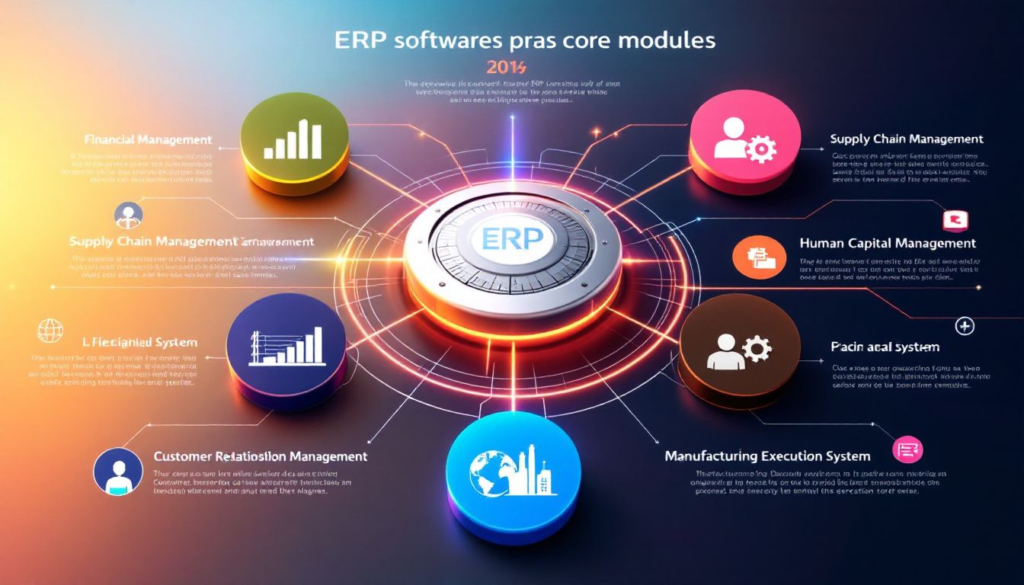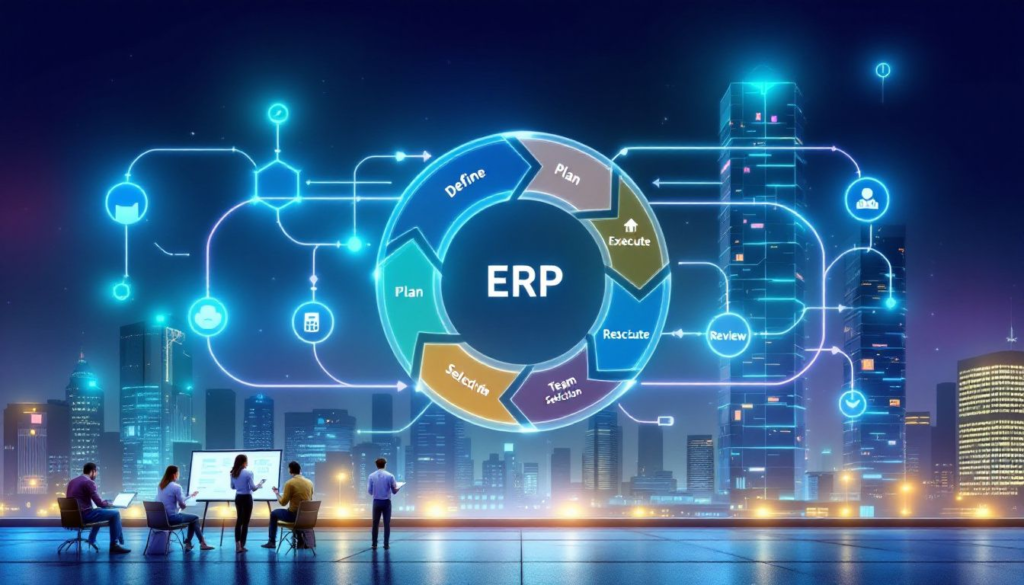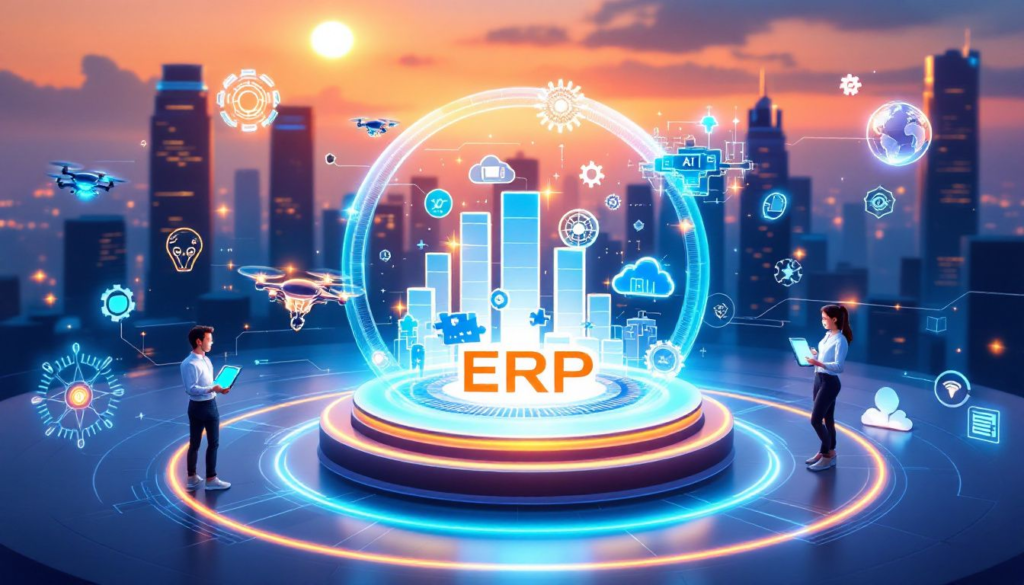Searching for ERP Software: The Ultimate Guide? This comprehensive guide explains what ERP software is, its key features, how to choose the best system, and implementation strategies. Get the insights you need to make smart ERP decisions.
Key Takeaways
ERP software integrates critical business processes to enhance efficiency, reduce costs, and improve profitability through automation and business intelligence.
Choosing the right ERP system requires a thorough understanding of business needs, budget considerations, and vendor reputation to ensure alignment with organizational goals.
Emerging trends in ERP systems, such as AI, blockchain, and IoT integration, are reshaping the landscape, emphasizing the need for secure, efficient, and sustainable business solutions.
Understanding ERP Software

ERP software, or Enterprise Resource Planning software, is designed to integrate and manage critical business processes. An ERP system primarily aims to enhance efficiency, reduce costs, and boost profitability. This is achieved by automating repetitive tasks, unifying various business functions, and providing business intelligence tools that deliver insights into business performance.
ERP systems manage essential functions such as sales, purchasing, accounting, and human resources through connected yet distinct modules. This modular approach allows businesses to customize their ERP systems according to their specific needs. For example, an inventory management module can provide real-time insights into stock levels, helping prevent stockouts and manage costs efficiently.
User-friendliness in ERP software ensures that all employees, regardless of technical proficiency, can use the system effectively through an intuitive interface and accessible design. This ease of use enhances user adoption and ensures that the ERP system supports all employees in their roles.
Small businesses, in particular, can benefit significantly from the right ERP system. By enhancing efficiency, streamlining operations, and boosting productivity, ERP software can help small businesses compete with larger enterprises. Selecting the appropriate ERP system involves finding a solution that aligns with your business needs and supports your growth objectives.
Evolution of ERP Systems
The journey of ERP systems began in the 1960s with the creation of Material Requirements Planning (MRP) systems. These early systems were designed to manage inventory and production in manufacturing environments. MRP addressed challenges in inventory management, production scheduling, and procurement, enabling better tracking of raw materials and optimizing shop floor processes.
In the 1980s, MRP II systems were introduced, expanding manufacturing processes beyond basic inventory management to include production planning, scheduling, and project management. By 1990, the term ‘enterprise resource planning’ was adopted to reflect the broader application of these systems across various business functions.
The late 1990s saw a significant shift with the emergence of cloud ERP solutions. These systems allowed businesses to access ERP software via the internet without significant hardware investments, making ERP more accessible to small and medium-sized enterprises. The concept of ERP II, introduced by Gartner in 2000, emphasized the integration of ERP systems with other business applications, enhancing their functionality and flexibility.
Modern ERP systems leverage real-time data processing and incorporate advanced technologies such as machine learning and the Internet of Things (IoT). These innovations enable businesses to automate complex processes, gain deeper insights through predictive analytics, and improve decision-making. The evolution of ERP systems reflects the continuous advancement in technology and the growing need for integrated business solutions.
Core Modules of ERP Software

ERP software encompasses several core modules that streamline business operations and enhance efficiency. The finance module, for instance, enables businesses to track financial performance, automate tasks such as billing and account reconciliation, and manage cash flow, providing a clearer view of financial health. This module is essential for any business looking to maintain robust financial management practices and utilize effective business software.
Human resources management modules maintain detailed employee records, automate HR tasks, and focus on enhancing workforce productivity. By centralizing HR functions, businesses can ensure compliance with labor laws, manage employee benefits, and streamline recruitment processes.
Inventory management modules offer insights into stock levels and help prevent stockouts while managing costs. These modules work in tandem with supply chain management modules, which oversee the flow of goods across the entire supply chain, ensuring timely delivery and optimizing inventory levels.
Order management modules, on the other hand, track customer orders from placement to delivery, ensuring timely fulfillment and enhancing customer relationship management and satisfaction.
Other important modules include professional services automation, which manages project resources and facilitates task tracking and billing, and procurement modules, which automate purchasing processes and manage vendor relationships. Warehouse management modules optimize warehouse processes to improve efficiency and accuracy, while manufacturing modules track production processes and ensure necessary materials are available.
Together, these modules form an integrated ERP system that supports various business functions.
Deployment Models for ERP Software

Selecting the right deployment model for your ERP software is crucial as it influences costs, scalability, and security. The three primary deployment models are on-premises, cloud-based, and hybrid. Each model has its advantages and challenges, and the choice depends on your organization’s specific needs and resources.
On-premises ERP solutions allow businesses complete control over their data and security. However, they come with higher upfront costs and require significant IT resources for maintenance and upgrades. This model is often preferred by larger organizations with the necessary infrastructure and security concerns.
Cloud ERP systems, on the other hand, offer easier scaling as businesses grow. These systems are designed to accommodate expansion, making them ideal for small and medium-sized enterprises. While cloud ERP solutions can be less secure than on-premises ones, leading vendors continuously enhance their security measures to mitigate risks, providing a scalable solution.
Hybrid ERP combines on-premises and cloud capabilities, providing flexibility and improved scalability. This model allows organizations to retain control over critical data while leveraging the benefits of the cloud for other functions. However, hybrid ERP setups can face slower deployment due to their complex nature, necessitating more IT oversight. Understanding the total cost of ownership and the specific needs of your business is vital for choosing the right ERP deployment model.
Choosing the Right ERP System
Choosing the right ERP system is a critical decision that can significantly impact your business’s efficiency and growth. This process involves evaluating ERP systems, your business needs, budget considerations, and vendor reputation. A thorough assessment ensures that the chosen ERP system aligns with your operational requirements and supports your strategic goals.
Evaluating business needs involves understanding the specific functionalities required for your industry and business processes. This step is crucial for identifying the core modules and features that will address your pain points and enhance productivity.
Budget considerations include evaluating the total cost of ownership, including upfront costs, maintenance, and expected ROI. Finally, choosing a reputable vendor with a proven track record ensures smooth implementation and reliable support.
The following subsections will delve deeper into these aspects, providing a detailed guide on evaluating business needs, budget considerations, and vendor reputation. By following these guidelines, you can make an informed decision and select the best ERP system for your organization.
Evaluating Business Needs
Understanding and defining the organization’s needs is the first step in selecting an appropriate ERP system. This involves considering the fit of the ERP system for your business and industry, the maturity of its capabilities, and its ability to handle core processes effectively. Gathering comprehensive requirements from stakeholders across various departments ensures the ERP system aligns with organizational needs.
Determining pain points and areas for improvement is key to identifying necessary ERP functionalities. For example, if inventory management is a significant challenge, an ERP system with robust inventory management capabilities should be prioritized. Engaging stakeholders in the ERP selection process enhances alignment with organizational needs and ensures that the system addresses specific business challenges.
Analyzing how well an ERP solution meets the defined requirements is vital. This analysis should consider the system’s ability to integrate with existing software and support the organization’s growth objectives. A thorough evaluation of business needs enables organizations to select an ERP system that provides the necessary functionality and flexibility to drive efficiency and productivity.
Budget Considerations
Budget considerations play a crucial role in selecting the right ERP system. The cost factors involved in ERP implementation include upfront costs, ongoing maintenance, support, and upgrades. Organizations should consider subscription fees, licenses, implementation costs, customization costs, and hidden costs when evaluating an ERP system.
For small businesses, the average cost of an ERP system ranges from $150,000 to $750,000. These costs can vary significantly based on the features and services required, the number of users, and the modules selected. A cost advantage of cloud ERP compared to on-premises ERP is its cheaper purchase, deployment, and maintenance.
Total Cost of Ownership (TCO) evaluates all costs associated with an ERP system, from procurement to long-term maintenance. Aligning these costs with budget constraints and expected ROI is essential for making an informed decision. By carefully planning and evaluating budget considerations, organizations can select an ERP system that offers the best value for their investment.
Vendor Reputation
Selecting a trustworthy ERP vendor ensures smooth implementation and ongoing support. A vendor’s reputation can significantly impact the success of the ERP project. Therefore, it is important to maintain objectivity when evaluating vendor reputations.
Common support services offered by ERP vendors include tech support, help desks, FAQs, user manuals, and training. Evaluating the vendor’s reputation and the quality of their support services enables better decision-making during the ERP selection process. Evaluating a vendor’s track record in specific industries can provide insights into their expertise and reliability.
A reputable vendor with a proven track record ensures that the ERP system will be implemented effectively and that any issues will be promptly addressed. Considering vendor reputation as a key factor in the ERP selection process helps organizations choose a partner that supports their long-term success.
Implementation Strategies for ERP Systems

Implementing an ERP system is a complex process that requires strategic foresight, meticulous planning, and a commitment to managing change. An appropriate implementation strategy significantly influences the success of the ERP transition. This section will outline key strategies for successful ERP implementation, including project planning, team selection, and change management.
Comprehending core business processes is crucial for selecting an ERP that aligns with operational requirements. Continuous improvement post-implementation adapts the ERP system to evolving business needs and technology. Successful ERP implementation requires selecting the right software, fostering organizational alignment, and prioritizing people and processes alongside technology.
The following subsections will delve into detailed strategies for project planning, team selection, and change management. Adhering to these guidelines helps organizations ensure a smooth and successful ERP implementation.
Project Planning
The initial planning phase is critical for the success of an ERP implementation. It involves gathering insights from various business groups to identify their needs and challenges. This information is essential for defining the scope of the ERP project and setting realistic goals.
Assembling a skilled project team is a key aspect of project planning. Successful ERP implementation often depends on having team members with relevant skills rather than just high-ranking titles. The project team should include representatives from different departments to ensure that all business processes are considered.
Vendor experience in specific industries can significantly influence the success of an ERP implementation. Choosing a vendor with a proven track record in your industry ensures that the ERP system will be tailored to meet your specific needs. Careful planning and assembling a skilled project team lay the foundation for a successful ERP implementation.
Team Selection
Forming a dedicated project team is crucial for the successful implementation of an ERP system. Clear roles and responsibilities ensure accountability and effective collaboration among team members. This prevents overlapping responsibilities and confusion during the ERP project.
The project team should include members with diverse skills and expertise relevant to the ERP system and the organization’s needs. For example, representatives from sales, marketing, finance, and IT can provide valuable insights into their respective areas. This diversity ensures that the ERP system addresses all business functions and processes.
Defining clear roles and assembling a skilled project team ensures effective management of the ERP implementation. This leads to better coordination, faster decision-making, and a higher likelihood of success.
Change Management
A comprehensive change management strategy is essential for ensuring employee adaptation to the new ERP system. Change management involves preparing, supporting, and helping individuals, teams, and organizations in making organizational change. It is crucial because successful ERP adoption requires modifying established work habits and processes.
Effective change management strategies include clear communication, training programs, and continuous support. Clear communication helps all employees understand the benefits of the new ERP system and its impact on their roles. Training programs provide the necessary skills to use the system effectively, while ongoing support ensures that any issues are promptly addressed.
Ongoing support ensures ERP systems align with operational needs as the business evolves. Adopting a comprehensive change management strategy facilitates a smooth transition to the new ERP system and achieves long-term success.
Common Challenges in ERP Implementation
Implementing ERP systems can be fraught with challenges that, if not managed properly, can derail the entire project. One common issue is underestimating the time and resources required for a successful ERP deployment, leading to budget overruns. Cost overruns are often due to underestimating the workload and additional expenses like training and consultancy.
Data migration is another critical challenge. Identifying and consolidating data from several sources can be more complicated than anticipated. Ensuring data quality involves removing duplicates and correcting inconsistencies before migration. Poor data quality can lead to significant issues post-implementation, affecting the ERP system’s performance and reliability.
Managing multiple phases of the ERP project requires thorough planning to keep all aspects aligned. Inadequate business process optimization, poor change management, and strategic misalignment commonly contribute to the high failure rate of ERP implementations. Addressing these challenges proactively can significantly improve the chances of a successful ERP implementation.
Emerging Trends in ERP Systems

The ERP landscape is continually evolving, with new trends shaping the future of enterprise resource planning. A significant trend is the integration of Artificial Intelligence (AI) and Machine Learning into ERP systems. These technologies enhance decision-making by automating processes and analyzing large datasets, providing valuable insights for businesses.
Blockchain technology is also making its way into ERP systems to enhance transaction security and transparency. By utilizing advanced cryptographic algorithms, Blockchain ensures that data is secure and tamper-proof, which is crucial for financial transactions and supply chain management. Strengthening cybersecurity measures is essential as ERP systems increasingly handle sensitive data and electronic transactions.
Sustainability is another emerging trend in ERP solutions. Modern ERP systems are incorporating sustainable practices to minimize waste and promote responsible resource use. Additionally, the integration of the Internet of Things (IoT) allows for real-time monitoring of operations and inventory, leading to improved efficiency and reduced downtime.
These emerging trends highlight the continuous advancement in ERP technologies and the growing need for integrated, secure, and sustainable business solutions. Staying abreast of these trends allows organizations to leverage the latest innovations to enhance their ERP systems and drive business growth.
Case Studies of Successful ERP Implementations
Real-world case studies offer valuable insights into the successful implementation of ERP systems. For instance, Mayo Clinic achieved a streamlined process for patient records, billing, and resource allocation through its ERP implementation. This integration led to improved patient care and operational efficiency.
Cadbury’s implementation of SAP ERP enhanced its resource management and optimized warehousing, resulting in reduced costs and improved manufacturing efficiency. Nestlé’s successful ERP integration across its operations improved communication across the supply chain and modernized its accounting systems.
ABC Compounding transitioned to Sage ERP X3, automating work orders and streamlining inventory transfers, significantly improving operational efficiency. Amazon’s effective use of ERP systems enhanced customer satisfaction and solidified its market position.
These case studies demonstrate the tangible benefits of ERP systems and the best practices followed by successful organizations. Learning from these examples helps other businesses adopt similar strategies and achieve successful ERP implementations. The key takeaways from these case studies include the importance of thorough planning, stakeholder engagement, and continuous improvement.
Summary
ERP systems are transformative tools that integrate various business processes into a unified system, driving efficiency and growth. Understanding the evolution of ERP systems, from MRP in the 1960s to modern AI and IoT-enabled solutions, provides context for their capabilities and benefits. Core modules such as finance, HR, and inventory management streamline operations and enhance productivity.
Choosing the right ERP system involves evaluating business needs, budget considerations, and vendor reputation. Successful implementation requires strategic planning, assembling a skilled project team, and a comprehensive change management strategy. Addressing common challenges such as cost overruns and data migration issues is crucial for success.
Emerging trends like AI, Blockchain, and IoT are shaping the future of ERP systems, offering new opportunities for enhanced decision-making, security, and sustainability. Learning from successful case studies, businesses can adopt best practices and achieve their ERP goals. With the right approach, ERP systems can revolutionize business operations and drive long-term success.
Frequently Asked Questions
What is the primary goal of ERP software?
The primary goal of ERP software is to enhance efficiency and reduce costs by integrating and managing various business processes, ultimately leading to increased profitability.
What are the common challenges in ERP implementation?
Common challenges in ERP implementation include underestimating the necessary time and resources, encountering data migration issues, managing multiple phases, and ensuring data quality. Addressing these challenges early can significantly improve your implementation success.
How do emerging technologies like AI and Blockchain impact ERP systems?
Emerging technologies like AI and Blockchain significantly enhance ERP systems by automating decision-making processes and improving transaction security and transparency. This integration leads to more efficient operations and increased trust in data handling.
Why is vendor reputation important when selecting an ERP system?
Vendor reputation is essential when selecting an ERP system because a reliable vendor facilitates smooth implementation and provides ongoing support, significantly impacting the project’s success. Choosing a trusted vendor helps minimize risks and ensures a successful ERP experience.
What are the benefits of cloud-based ERP systems?
Cloud-based ERP systems provide easier scaling, lower upfront costs, and reduced maintenance efforts, making them a more efficient choice for businesses seeking flexibility and cost savings.





